PARISH OF SEAPATRICK
by Fr. Andrew McMahon
The modern parish of Seapatrick, `the seat of
Patrick', is dominated by the town of Banbridge, though it actually
contains sixteen townlands. It is bordered on the north by the parishes
of Tullylish and Dromore and to the south by Aghaderg and Annaclone. The
area covered by the parish has a substantial Protestant majority. The
current Catholic population is estimated to be around 5,000.
The modern parish is, in diocesan terms, a relatively
recent creation. It was established by Dr. Michael Blake, Bishop of
Dromore, on 10th. November 1851. Prior to this, Seapatrick Catholics had
been ministered to as part of the `Tullylish Union', by priests resident
within Tullylish Parish. In time, Banbridge came to have a
`curate-in-residence'- this obviously paved the way for the creation of
the distinct parish.
ANCIENT AND MEDIEVAL PERIODS
Although the name Seapatrick suggests connections
with the national patron, the ancient religious traditions of the parish
are unrecorded. A pre-Reformation Church existed at Kilpike, about a
mile and a half from the centre of the modern town, to the north west.
One suggestion is that Kilpike derives from the Irish `Cill P�draic'
implying a connection with Patrick. By the middle ages we find the more
familiar `Soyge Padraig' and `Suide Padruic' being used in some
documents, leading to the current `Seapatrick'.
A new Protestant church, built in 1670, at Kilpike
probably replaced the ancient church there. This church continued to
serve its people until it was superseded by the new Holy Trinity (Church
of Ireland) Parish Church, erected in 1834. An ancient church also
existed at Magherally. Ordnance Survey notes, written in 1834,
acknowledge this and suggest that ruins of this original Magherally
Church had been visible until some years before the time of writing.
Catholic worshippers in the parish probably continued to use a church at
Kilpike and a church at Magherally into the early Reformation period
and, in time, took refuge at such secret Mass stations as existed. Of
these, we know two: Ballydown Mass Fort, which was situated about half a
mile from the centre of the town to the south east and Tonaghmore Mass
Fort, three miles north of Banbridge town, close to the border with
Tullylish and Dromore Parishes. A glass ciborium, intended for the
distribution of Holy Communion, was found near this site at the
beginning of the last century. It has been used, for several years, at
the annual Cemetery Mass in Banbridge.

The advent of Banbridge itself belongs to the early
eighteenth century. According to James A. Pilson, in his Notices of the
most important events connected with the County Down, a bridge was
erected over the River Bann in 1712, "on the formation of a new line of
road from Dublin to Belfast". This bridge and its surroundings changed
the name of the locality to 'Banbridge' in popular usage and away from `Ballyvally',
the name of the townland in which Banbridge was originally situated.
The River Bann allowed for the development of the
linen industry along its banks and by the middle of the eighteenth
century we have evidence of many bleach yards along the river for the
purposes of linen manufacture. The Earl of Hillsborough, in turn,
granted sections of land at nominal rent to encourage building in the
vicinity of the Bann bridge and was responsible for the laying out of
the original town. According to records of the Hillsborough Estate
Office, Letters Patent for the holding of a weekly market and four fairs
annually were granted in 1727. By the mid 1700s, Banbridge had a
thriving Church of Ireland community and, also, an expanding
Presbyterian Church. According to the parliamentary return of Rev. James
Dickson, Church of Ireland Rector of Seapatrick Parish, writing on 24th.
April 1766: "There is neither Popish Priest nor Friar in this parish,
but the papists here go to Mass in a neighbouring parish." As mentioned
above, a Catholic parish of Seapatrick was not to be re-established
until almost a century later.
EARLY PARISH PRIESTS OF SEAPATRICK
Patrick Maguyn, (Maginn), according to De
Annatis Hiberniae, is mentioned as `Vicar of Sangpadrig' on October 2nd.
1405.
Philip Mac Gvyryn (MacGivern), according to
Swayne's Register, was `Vicar of Magherally' and died in 1428.
Magonius MacNyrgynid (Manus Maclnerney),
succeeded as `Vicar of Magherally' on August 4th. 1428.
Fr. James McMullan of `Kilpike' was attained
on 10th. July 1691, along with about one hundred others, and summoned to
appear before a commission on the charge of being active supporters of
King James II.
On 11th. July 1704, a Fr. Neil Byrne, resident
in Ballyvarley, was registered at Downpatrick as Parish Priest of
Seapatrick, Tullylish and Donaghcloney. Fr. Byrne was aged 54 years and
had been ordained priest by Dr. Daniel MacKey, Bishop of Down and
Connor, in 1671.
Rev. Hugh Sheile, (Shields), was registered as
priest-in-charge of Magherally and Garvaghy in 1704. He was then
residing at Corbet, aged 50 years, and had been ordained by Dr. McKey,
Bishop of Down and Connor, in 1674. He was Parish Priest of Drumgooland
in October 1691, when he was outlawed by the Williamites.
A Fr. Downey was named as Parish Priest of
Dromore, Seapatrick, Magherally, Magheralin and Garvaghy in 1720.
No further records exist, from this period, of
priests directly attached to Seapatrick or Magherally parishes. We can
presume, therefore, that these medieval parishes were subsumed around
this time within the so-called `Tullylish Union' Banbridge Catholics
were to be ministered to by priests living in the Laurencetown area
until 1851. Seapatrick does not re-emerge until then as an independent
parish.

`TULLYLISH UNION' PARISH PRIESTS
According to a report of the Church of Ireland
bishop, there were two priests residing within the parish of Tullylish
in 1731. Their names have not been established.
Fr. Francis Polin, a native of Mayobridge, was
Parish Priest of Tullylish at the time of his death in 1777. He had been
a priest as early as 1728. He was buried in Drumgath cemetery.
Very Rev. Dr. Arthur Magennis was Parish
Priest of the United Parishes of Tullylish, Donaghcloney, Seapatrick and
Magherally, following Fr. Polin. He died in April 1784.
Rev. Hugh O'Kelly succeeded Dr. Magennis in
Tullylish, in May 1784. He became Bishop of Dromore in January 1820. He
died at Newry in August 1825 and was buried in Laurencetown.
Rev. Edmund Magennis was appointed Parish
Priest of the united parishes on 10th. September, 1820. He is believed
to have been a native of Tullylish. He was ordained in Newry in 1816,
and served as curate in Newry from 1816 until 1820. Fr. Magennis was
responsible for the erection of St. Patrick's Church in Banbridge in
1839. Tensions arose during his pastorate between the bishop, Dr. Blake.
and Fr. Magennis. It appears that these had an effect upon the
administering of Seapatrick and Magherally. Fr. Magennis eventually
resigned his parish. He lived on in Knocknagore, near Laurencetown, and
died on 22nd May 1849, aged 56 years. He was buried in Laurencetown.
Rev. John Byrne, a native of Aghaderg and
curate in Tullylish since 1845, was appointed Administrator of the
united parishes following the death of Fr. Magennis. The period of the
`Union' was soon to come to an end, however, and on 10th. of November
1851 Seapatrick and Magherally were severed from it and established as a
distinct parish. Fr. Byrne became Parish Priest of the United Parishes
of Tullylish and Donaghcloney on 12th. November 1851. He died on 6th.
June 1877 and is buried in Laurencetown.
 2 2
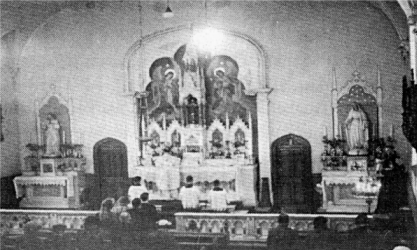
The sanctuary of St. Patrick's Church
in the days prior to the Second Vatican Council
(1962-65). Here a Wedding Mass is being offered for a
happy couple.
PRIESTS OF THE `TULLYLISH UNION'
RESPONSIBLE FOR SEAPATRICK PRIOR TO 1851
(sometimes referred to as `quasi-administrators' of
Seapatrick)
Fr. Henry O'Hagan officiated in the Banbridge
area
1831-1832. He had been a native of Clonduff, educated
at Maynooth and ordained in Newry in 1827. He worked in St. Colman's
College and Newry Parish prior to being appointed to the 'Tullylish
Union' in 1831. While ministering in the area he seems to have lived at
Hall's Mill, near Laurencetown. He was appointed Parish Priest of
Magheradroll on 8th. March 1832. He died on 19th. September 1833 and was
buried in Leitrim.
Fr. John Doran, a native of Aghaderg, seems to
have been resident in Banbridge from 1837 until 1840. He was probably
the first resident priest of the period, settling in the more tolerant
years following Catholic Emancipation. Fr. Doran was ordained in
Maynooth on 24th. May 1834. He was curate in Rostrevor from 1834-1837.
During his ministry in Banbridge, Fr. Doran was involved prominently in
the project of erecting St. Patrick's Church, Dromore St. He was
appointed Parish Priest of Aghaderg on 15th. August 1840. In 1 850 he
resigned from Aghaderg and went to the diocese of St. Louis, U.S.A.
Following Fr. Doran, Fr. Bernard Mooney lived
in the parish as curate until 1843. Fr. Mooney was born in Drumgath
Parish, educated at Maynooth and ordained in Newry in 1833. He was a
curate in Newry until October 1834 when he was appointed to the 'Tullylish
Union'. He resided in Banbridge following Fr. John Doran's departure.
Fr. Mooney was the first Catholic Chaplain of Banbridge Workhouse,
appointed in 1841 at a salary of �25 p.a. He continued to serve within
the 'Tullylish Union' until 1844. That year he was appointed curate in
Aghaderg, where he caught fever after attending a sick call and died on
20th. October 1847. He was interred in Lisnagade Church.
Rev. John Mackin served as curate-in-residence
from 19th. January 1843 until 1st. July 1844. He was a native of
Annaclone, educated at Maynooth and ordained by Dr. Blake in Newry in
1838. He served at Warrenpoint until his appointment to Banbridge in
1843. Fr. Mackin went to Annaclone as Adm. in 1844, and became Parish
Priest in 1848. He was transferred to Upper Drumgooland as P.P. in March
1851, retiring in 1855.
Rev. Bernard Maginn was appointed to Banbridge
on 7th. December 1844. A native of Omagh, he was educated at the Irish
College, Paris and ordained in Newry in 1839. He was curate in
Magheralin (184243)and Drumgath (1843-44). Fr. Maginn is believed to
have died suddenly in St. Patrick's Church, Banbridge, in February 1847.
Rev. John Callan was appointed to Banbridge on
7th. March 1847. He appears, however, not to have taken up the
appointment initially and continued as a curate in Newry until 1848. He
later went to Lurgan, where he was curate 1849-50.
Rev. Bernard Hughes was appointed to Banbridge
on 11th. March, 1847. A native of Newry, he was educated at Maynooth and
ordained by Dr. Blake in 1843. He served as curate in Newry (1843-44)
and Dromore (1844-47) before coming to Banbridge. He left Banbridge in
1848 to work in Warrenpoint. He became Parish Priest of Lower
Drumgooland in November 1854, where he died on 4th. March 1886.
Rev. Patrick Maclvor was appointed to
Banbridge on 8th. November 1848. He ministered there until 1854. During
his ministry in Banbridge, Seapatrick and Magherally became a distinct
parish, on 10th. November 1851. Rev. Daniel Mooney was appointed Parish
Priest of the new entity, Fr. Maclvor continuing as curate until 1854.

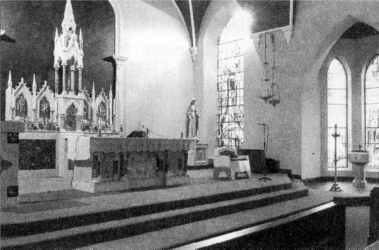
The interior of St. Patrick's Church
today. A major renovation took place 1981-82. The Church was
rededicated by Bishop Brooks on 21st. November 1982,
PARISH PRIESTS OF SEAPATRICK SINCE
ITS RE-ESTABLISHMENT
Rev. Daniel Mooney was appointed Parish Priest
of Seapatrick and Magherally by Bishop Michael Blake on 10th. November
1851. Fr. Mooney first appears in diocesan records as curate in Barnmeen,
1841-43. From information on his gravestone it is reasonable to conclude
that he had been newly ordained shortly before this appointment to
Barnmeen. He subsequently served as curate in Clonallon (1843-48),
Leitrim (1848-49), Donaghmore (1849-50) and Tullylish (July
1850-November 1851). Fr. Mooney died on 19th. March 1858, aged 46 years,
and was buried in Laurencetown.
Rev. John O'Brien was appointed Parish Priest
on 11th. June 1858. He was born in Aghalee in 1823, educated at Maynooth
and ordained by Bishop Blake in Newry on 10th. August 1848. He served as
curate in Newry (1848-58), some of which time he spent as acting
Administrator. Following his move to Banbridge, Fr. O'Brien became Vicar
Forane in July 1877. He was appointed Vicar General of the diocese on
4th. November 1878. He attended the Maynooth Synod in the autumn of
1900. As a result of the indisposition of Bishop McGivern during the
Synod, Fr. O'Brien was appointed Procurator Episcopi, Dromorensis' by
Cardinal Logue. He was, in consequence, a signatory to the statutes of
the Synod, on behalf of the Dromore Diocese. In November 1900 he was
appointed Vicar Capitular of the diocese, following the death of Dr.
McGivern. He was reappointed Vicar General by the new bishop, Dr. Henry
O'Neill, in May 1901. On 23rd. January 1905 Fr. O'Brien was appointed a
Domestic Prelate by Pope Pius X. Monsignor O'Brien died in Banbridge on
5th. September 1907, aged 84 years. He was interred in the sanctuary of
St. Patrick's Church, Banbridge, where his younger brother, Rev. Thomas
Henry O'Brien, had been interred in March 1871. This younger brother had
served as curate in Newry and in Ballela. Monsignor O'Brien had been one
of the founders and first directors of the Irish News, Belfast.
Fr. John Rooney was appointed Parish Priest on
30th. October, 1907. He was, at that point, on a lecture tour in America
on behalf of the Newry Cathedral Extension Fund. He returned to take up
his position on 19th September 1909. During his absence, Fr. Michael
MacClory, S.T.L., CC, administered the parish. Fr. Rooney had been born
in Mayobridge, educated at Maynooth and ordained on 24th. June, 1878. He
served as curate in Ballela (1878-84) and in Newry (1884-1906). He
became Administrator of Newry on 27th. December 1906 and began his
lecture work abroad. Following Banbridge, Fr. Rooney was appointed
Parish Priest of Clonduff on 1st. September, 1923. He became a member of
the Cathedral Chapter in November 1924 and in November 1925 he was
appointed Diocesan Chancellor. Canon Rooney was a noted preacher and
promoter of temperance. He died on 20th. June 1930, aged 75 years, and
was buried in Hilltown.

Fr. Francis Joseph O'Hare succeeded Fr. Rooney
in Banbridge on 2nd. September 1923. Also a native of Mayobridge, he was
born in 1867, educated at Maynooth and ordained by Archbishop Walsh on
24th. June 1890. A brother, Fr. Hugh O'Hare, also served as a priest of
the Dromore Diocese. Fr. Francis was curate in Clonduff (1890-95),
Seagoe (18951904), and was on a lecture tour in America in aid of Newry
Cathedral from November 1904 until March 1910. He was curate in Newry
(1910-23) and Administrator from 25th. June 1923 until his appointment,
that year, to Banbridge. Fr. O'Hare became a member of the Cathedral
Chapter in July 1930 and `Canon Theologian' in July 1935. Canon O'Hare
was a respected and influential speaker and writer. He regularly
contributed articles to the Newry Telegraph and to the Irish News. He
was a strong advocate of the Allied Cause during the First and Second
World Wars. Canon O'Hare died on 4th. June 1951 and was buried in
Banbridge Cemetery.
Fr. David Gallery was appointed Parish Priest
of Seapatrick on 25th. June 1951. A native of Magheralin, he was
educated at Maynooth and ordained by Archbishop Walsh on 10th. June
1910. Fr. Gallery served as curate in Seagoe (1921-22) and Lurgan
(1922-36). He was Parish Priest of Upper Drumgooland (1936-41) and
Aghaderg (1941 -51) In April 1950 he became a member of the Cathedral
Chapter and Diocesan Chancellor. While in Banbridge Canon Gallery became
Archdeacon, on 21st. March 1955. Archdeacon Gallery died on 17th. May
1963 and was buried in Banbridge.
Fr. James Haughey, President of St. Colman's
College, was appointed to Banbridge, in succession to Archdeacon
Gallery, on 10th. June 1963. Fr. Haughey was a native of Aghaderg, was
educated at Maynooth and ordained by Dr. Wall, Auxiliary Bishop of
Dublin, in June 1934. He served on the staff of St. Colman's College
from 1934, becoming President in 1959. His pastorate in Banbridge was
relatively short, as he was transferred as Parish Priest to Lurgan on
1st April 1964. He was responsible during his months in Banbridge for
the purchase, by the parish, of the lands later used for the building of
St. Mary's Primary School, St. Teresa's Church and a new Parochial House
on the Scarva Road. On moving to Lurgan, Fr. Haughey was appointed Vicar
General of the diocese and a member of the Cathedral Chapter. He became
Archdeacon of the Chapter in 1972, Dean and Domestic Prelate in 1976.
Monsignor Haughey retired on 16th. January 1980. He died on 16th. March
1995 and was buried in Rostrevor.
Fr. James McEvoy was appointed Parish Priest
of Seapatrick on 2nd. April 1964. A native of Lower Drumgooland Parish,
he was educated at the Irish College Rome and ordained in Rome in 1935.
He served as curate in Down and Connor Diocese (193536), Magheralin
(1936-41), Ballela (1941-43), Rathfriland (1943-45), Gilford (1945-48)
and Lurgan (1948-64). Fr. McEvoy was transferred from Banbridge to
Drumgath as P.P. on 22nd. January 1972. He died on 18th. November 1985
and was buried at Barnmeen.
Fr. Michael Henry O'Rourke was appointed
Parish Priest on 22nd. January 1972. A native of Upper Drumgooland, he
was educated at St. Kieran's College, Kilkenny and the Irish College,
Rome, where he was ordained in April 1939. He served in Leeds Diocese
(1939-43), as curate in Gargory (1943-48), Gilford (1948-59) and
Derrytrasna (1959-67). Fr. O'Rourke became Parish Priest of Dromara in
October 1967 and was transferred to Banbridge five years later. During
his pastorate of Seapatrick Parish, the new Church of St. Teresa was
built and the adjoining Parochial House. He was appointed to the
Cathedral Chapter in July 1980. Canon O'Rourke died on 19th. November
1987 and was buried in the grounds of St. Teresa's Church.
Fr. Matthew O'Hare was appointed to Banbridge
in succession to Canon O'Rourke on 17th. January 1988. A native of
Donaghmore Parish, he was educated at Maynooth and ordained by
Archbishop McQuaid in June 1950. He worked temporarily in Shrewsbury
Diocese (1950-54), was curate in Annaclone (195455), Warrenpoint
(March-October 1955), Saval (1955-59), Seapatrick (1959-62), Newry
(1962-77), and Lurgan (1977-84). Fr. O'Hare was appointed Parish Priest
of Clonduff in January 1984 and was transferred to Banbridge four years
later. He became a member of the Cathedral Chapter in December 1992.
Canon O'Hare retired in June 2000.
Canon Liam Stevenson succeeded Canon O'Hare on
16th. June 2000. A native of Seagoe Parish, he was educated at Maynooth
and ordained by Bishop O'Doherty in Newry on 18th. June 1972. He was
appointed to the teaching staff of St. Colman's College, Newry in August
1972 and became President of the College on 20th. August 1994. Fr.
Stevenson was appointed to the Cathedral Chapter on 14th. October 1994.

CURATES OF SEAPATRICK PARISH
Hugh Mooney, 1854-63; Patrick Polin, 1856-63; James
O'Hare, 1863-68; Daniel Mallon, March-September 1868; Stephen MacNulty,
1868-70; John Quail, 1870-77; Bernard MacAleenan, 1877-95; Thomas
Bernard Rooney, 1894-1902; John MacAllister, 1895-1900; Eugene MacPolin,
1902-05; John Lupton, 1900-03; John Joseph Burns, February-July 1903;
Henry Doran, 1903-07; John MacGivern, 1905-07; Hugh Boyle, 1907-09;
Michael MacClory, 1907-20; John Magee, 1909-11; Patrick Joseph Wims,
1912-13; Patrick Greenan, 1913-17; Edward J. McAteer, 1917-19; Daniel
Pollen, 1919-35; Michael F. Gallogly, 1921-30; Thomas Carvill, 1935-52;
Christopher Francis Murray, 1946-59; Patrick McAnuff, 1956-67; Matthew
O'Hare, 1959-62; Roderick McInerney, 1962-64; Patrick Scahill, 196263;
John Murtagh, 1964-66; Thomas Seymour, 1966- Michael Sheedy, 1967-68;
Arthur Bradley, 1968-James O'Hanlon, 1969-70; Seamus Lavery, 197072;
John Synnott, 1970-71; Aidan Hamill, 1971-80; Oliver Mooney, 1972-76;
Gerard Green, 1976-88; Jarlath Cushenan, 1980-85; Brian Brown, 1984-85;
James Kerr, 1985-88; Francis Kearney, 1985-94; James Poland 1988-2001;
John Byrne, February-September 1992; James Galvin, 1994; Michael
Farrell, 1995-2000; Anthony Corr, 2000; Martin McDonagh, CSSp.
2001-2003; Martin McAlinden, 2003-2004; Patrick Reedy, CSSp. 2004.

The late Canon Michael Henry O'Rourke was the
popular and highly respected Parish Priest of Seapatrick from
1972 to 1987. His remains lie within the grounds of St. Teresa's
Church.

ST. PATRICK'S CHURCH,. DROMORE
STREET, BANBRIDGE
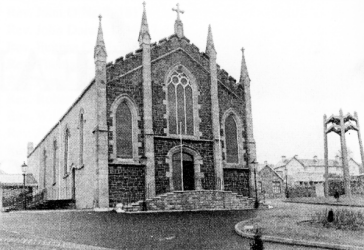
St. Patrick's Church, Dromore Street,
Banbridge. It was originally completed in 1839 and
dedicated by Bishop Michael Blake in June 1841.
The Church of St. Patrick, Dromore Street, was
originally completed in 1839. The planning of it was begun in 1835 by
Rev. Edmund Magennis, Parish Priest of Tullylish, Donacloney, Seapatrick
and Magherally. According to visitation notes of Bishop Michael Blake,
in 1842, the site for the church was on ground held by lease from a
Thomas McClelland Esq., "in consideration of �52 given on purchase by
Rev. E. Magennis." The architect for the church, of formal Gothic
design, was Thomas J. Duff who had previously designed Newry Cathedral
and St. Patrick's Church, Loughbrickland. Work on the building had to be
suspended in March 1837, due to a shortage of money, with �450 having
already been spent by that date. Much assistance in the building project
was generously given by the McComish Family of Banbridge. The church was
eventually dedicated on 2 I st. June 1841 by Dr. Blake. The sermon at
this dedication ceremony was delivered by the renowned Temperance
preacher Fr. Theobald Mathew, on what is believed to have been his first
visit to the diocese of Dromore. According to local tradition, for
several years after opening, St. Patrick's still had an earthen floor.
Parishioners who could afford them, brought their own kneelers, with
others kneeling on the bare ground. A bell tower was erected close by
the church, on the town side, in 1885, and in 1890 a gallery was added
to St. Patrick's.
In 1910 a new high altar was constructed. A major
redecoration followed in 1924. The mid -1920s saw a variety of
developments in the facilities of Seapatrick Parish; the Parochial House
was extended, a new chapel carne into being at Drumnavaddy, and the
parish primary schools were renovated and extended. These obviously
placed heavy demands, financially, on the people of the parish. At a
Pontifical High Mass celebrated by Bishop Mulhern on Sunday 3rd. May
1931, the Archbishop of Liverpool, Most Rev. Richard Downey preached a
Charity Sermon in aid of parochial funds. Cardinal MacRory was in
attendance, as were the Bishop of Derry, Dr. O'Kane and the Bishop of
Down and Connor, Dr. Mageean. Several members of the Northern Ireland
parliament were among the congregation. The collection taken up amounted
to over �700.
Later that year, on Sunday 25th. October, a new
window by Mayer of Munich was dedicated at St. Patrick's Church. The
window was the gift of a New York benefactor and celebrated St. Therese
of Lisieux, the young saint canonised in 1925.
The centenary of the completion of the original
building of St. Patrick's was celebrated in 1939. On Sunday 26th.
November, Solemn High Mass was offered by Rev. James Burke, C.C. Newry,
with Bishop Mulhern presiding. The sermon was preached by Rev. Dr.
Arthur Ryan of Queen's University, Belfast. Bishop Mulhern and Dr. Ryan
were both to return to St. Patrick's, Banbridge some months later, on
Sunday 30th. June 1940 - the occasion being the Golden Jubilee of
Ordination of the Parish Priest, Canon Frank O'Hare. Congratulations
were read, at this ceremony, from both Cardinal MacRory and the
Apostolic Nuncio, Most Rev. Dr. Robinson.
Minor modifications were undertaken during the
following decades, but the most significant renovation and reordering
came in the early 1980s under the guidance of Canon Michael O'Rourke.
Altar railings were removed, the sanctuary was extended, and the
original high altar was extended and repositioned, in accordance with
the liturgical norms of the Second Vatican Council. Marble from the
altar rails was used in the construction of a new lectern and
celebrant's chair. A baptistry was constructed at the edge of the
extended sanctuary, embellished by a trio of stained glass windows
depicting the baptism of Christ. New seating and confessionals were also
installed and new sacristy facilities were built. St. Patrick's Church
was solemnly rededicated and reopened by Bishop Brooks on 21st. November
1982. During the ceremony, relics of St. Pius X, St. Clement Hoffbar and
St. John Neumann were placed in the newly adapted altar. Seapatrick
Parish marked the 150th. Anniversary of the dedication of St. Patrick's
in 1991: A, special Anniversary Mass was celebrated by Bishop Brooks on
27th. October. The homily for the occasion was delivered by Rev. Dr.
John McAreavey, a native of the parish, later to become Bishop of
Dromore.
OUR LADY, QUEEN OF PEACE CHURCH,
DRUMNAVADDY
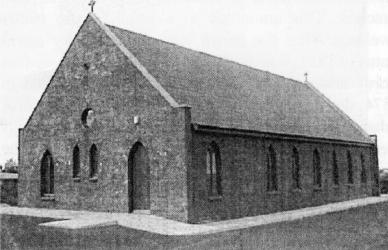
A converted dwelling house was
dedicated as a church at Drumnavaddy in August 1924. It
was replaced by the new Mary, Queen of Peace Church,
opened on 15th. March 1992.
A building (formerly a dwelling house) at Drumnavaddy
was converted into a small chapel of ease in 1924, under the direction
of Fr. Frank O'Hare. It was blessed and opened on 17th. August 1924 and
dedicated to Our Lady, Queen of Peace. The opening Mass was celebrated
by Rev. Daniel Pollen. Fr. O'Hare was, himself, the preacher at this
Mass. The following year, on 16th. June 1925, Bishop Mulhern visited the
new chapel for the erection of the Stations of the Cross.
The chapel of ease at Drumnavaddy was replaced by a
new church built in 1991/92. This project was undertaken by a local
building committee under the chairmanship of Mr. Sean McAnearney. The
architect was Paul Monaghan. The new church, also dedicated to Mary,
Queen of Peace, was blessed and opened by Bishop Brooks on Sunday 15th.
March 1992. Monsignor Christopher Murray delivered the homily at this
Mass.
The new church was, unfortunately, damaged in a fire
attack in August 1993. The consequent repair cost over �30,000. It was
vandalised and smoke damaged in a further attack on 9th. January 1994.

ST. TERESA'S CHURCH, SCARVA ROAD,
BANBRIDGE
By the mid 1970s it was clear that a growing Catholic
population in Banbridge needed the facility of a second church building
within the town. A site which had been purchased from the Coburn family
in 1964 was available for this purpose. After a house there was
demolished in 1976, work on the proposed new church began in April 1977.
The foundation stone was blessed by Bishop Brooks on Sunday 9th. October
1977. The new church, dedicated to St. Teresa, was of a `surround'
design. It was built by the company, Laneir Ltd. of Wakefield, at a cost
of �170,000. St. Teresa's was solemnly dedicated and opened by Bishop
Brooks on Sunday 14th. May 1978. The new church boasted a seating
capacity of 800. Plans are currently being drawn up for a replacement of
this church.
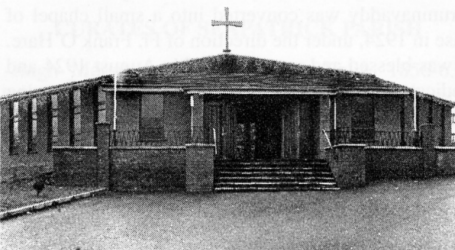
St. Teresa's Church, of modern
`surround' design, was constructed 1977-78 on land
previously purchased on the edge of the town.
PARISH CEMETERY AND PAROCHIAL
HOUSES
The parish cemetery, on the Dromore Road, was
purchased in 1872. It was blessed by Bishop Leahy O.P. The cemetery was
extended and reordered around 1970.
At the time of the building of St. Patrick's Church
accommodation for a curate-in-residence was also attached. This amounted
to a small, single storey dwelling. After the parish was granted
independent status in 1851, this dwelling was enlarged and another
storey added in 1852. A third storey was added in 1874, during the
pastorate of Very Rev. J. O'Brien. A substantial later addition and.
other improvements were undertaken by Very Rev. F.J. O'Hare during the
years 1924-25.
In 1964 valuable sites were acquired for the parish,
by Fr. James Haughey, at the junction of Scarva Street and the Scarva
Road. One of these sites was later used for the construction of a parish
primary school. The other site contained a large house which was
occupied initially by the Parish Priest. This house was demolished in
1976 to make way for the construction of the new St. Teresa's Church.
Meanwhile a new home for the Parish Priest had been built close by, on
the same piece of land, in 1976. The architects were Messrs. Smith and
Fay, Newry, and the builder was Brendan Magee, Banbridge.
Early in 1981, as the work of renovating St.
Patrick's Church continued, a new house for the curates of the parish
was begun alongside the church at Dromore Street. On completion of this
house, the original presbytery to the rear of St. Patrick's was
demolished.

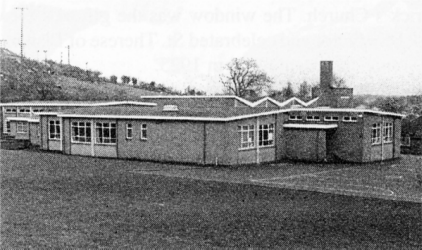 |
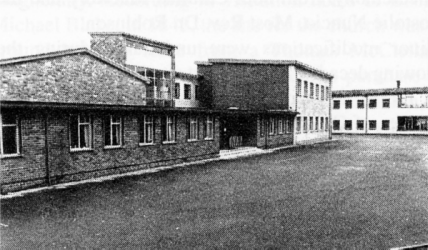 |
|
Catholic Education continues to be
provided in Banbridge at St. Mary's Primary School (left),
which was built in 1970, and St. Patrick's College (right),
opened in 1958. |
A mixed National School was opened in Banbridge in
1858, inside the grounds of St. Patrick's Church, fronting Dromore
Street. A separate school for girls was built in 1871, adjoining the
original school, which then continued for boys only. A second storey was
added to the Girls' School in 1876. The ground floor of the Girls'
School combined as a meeting/social centre for local parishioners for
many years afterwards. A programme" of extensions and improvements to
both schools was carried out from 1920 to 1925.
Census figures show a slow but continual rise in the
Catholic population figures in Banbridge over the following decades.
Although other adaptions were made to the Dromore Street schools, they
were increasingly inadequate as accommodation for the primary school
children of the parish. By 1962, Seapatrick Parish had 560 families in a
population of 2,282 Catholics. St. Patrick's Parochial Hall nearby, on
Ballymoney.Hill, came to be used from the 1950s as an overflow facility
for the primary schools. This practice continued until a new primary
school was built in 1970.
The new mixed parish primary school was opened in
Banbridge on Friday 1st. June 1971. Fr. James McEvoy P.P. initiated this
project and saw it to completion. St. Mary's Primary School was built at
the junction of the Scarva Road and Reilly Street on one of the sites
previously purchased by Fr. James Haughey P.P. The school continues to
thrive and has a current roll of 408 pupils, with 20 teachers.
Following the 1945 Education Act and the new era
which began in post-primary education, a new mixed intermediate school
for the parish and surrounding areas, St. Patrick's, was built at a cost
of �140,000. The foundation stone for St. Patrick's was blessed by
Bishop O'Doherty on 1st. May 1957. The school was blessed and opened by
Archdeacon Gallery on 1st. September 1958. It has developed and been
extended a number of times over recent decades. On Sunday 16th. March,
1984, the school community gathered at
St. Teresa's Church for a special Mass to mark their
Silver Jubilee year. More recently, on 22nd. March 2000, the school
assumed the title `St. Patrick's College'. The College has a current
roll of 530 pupils and 40 teachers. It is currently awaiting funding
from the Department of Education for the construction of a new school
building.
PAROCHIAL HALL
The above-mentioned St. Patrick's Parochial Hall was
opened in 1914. It was extensively renovated in the late 1960s, having
continued to accommodate primary school pupils. The Hall served as an
important social facility and a much cherished meeting place for young
Catholics of Banbridge and the surrounding areas for many years. It has
been superseded in recent years by a superb new Parish Centre, built
alongside St. Teresa's Church, on the Edenderry Road. The Centre was
opened on 2nd. October 1998. Its architect was B.G. Laverty of Banbridge
and the building contractors were McCartan Brothers of Laurencetown. The
main hall of the Parish Centre has a seating capacity of 600.
St. Patrick's Hall is currently being sold.
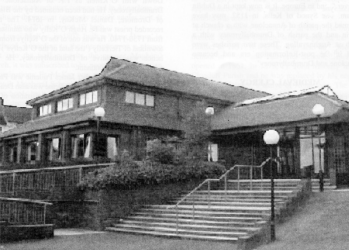
The new 'Parish Centre', on the
Edenderry Road, provides Banbridge people with a
very fine pastoral and social facility.
 |